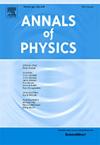Observable measurement-induced transitions
IF 3
3区 物理与天体物理
Q2 PHYSICS, MULTIDISCIPLINARY
引用次数: 0
Abstract
One of the main postulates of quantum mechanics is that measurements destroy quantum coherence (wave function collapse). Recently it was discovered that in a many-body system dilute local measurements still preserve some coherence across the entire system. As the measurement density is increased, a phase transition occurs that is characterized by the disentanglement of different parts of the system. Unfortunately, this transition is impossible to observe experimentally for macroscopic systems because it requires an exponentially costly full tomography of the many-body wave function or a comparison with the simulation on an oracle classical computer. In this work we report the discovery of another measurement-induced phase transition that can be observed experimentally if quantum dynamics can be reversed. On one side of this phase transition the quantum information encoded in some part of the Hilbert space is fully recovered after the time inversion. On the other side, all quantum information is corrupted. This transition also manifests itself as the change in the behavior of the probability to observe the same measurement outcome in the process that consists of identical blocks repeated many times. In each block the unitary evolution is followed by the measurement. On one side of the transition the probability decreases exponentially with the number of repetitions, on the other it tends to a constant as the number of repetitions is increased. We confirm the existence of the proposed phase transition through numerical simulations of realistic quantum circuits and analytical calculations using an effective random-matrix theory model.
可观察到的测量引起的跃迁
量子力学的一个主要假设是测量破坏量子相干性(波函数坍缩)。最近发现,在多体系统中,稀局部测量仍然在整个系统中保持一定的相干性。随着测量密度的增加,发生相变,其特征是系统不同部分的解纠缠。不幸的是,这种转变不可能在实验中观察到宏观系统,因为它需要指数级昂贵的多体波函数的全层析成像或与oracle经典计算机上的模拟进行比较。在这项工作中,我们报告了另一种测量诱导相变的发现,如果量子动力学可以逆转,则可以通过实验观察到这种相变。在相变的一侧,编码在希尔伯特空间的某些部分的量子信息在时间反转后被完全恢复。另一方面,所有的量子信息都被破坏了。这种转变也表现为在由重复多次的相同块组成的过程中观察到相同测量结果的概率行为的变化。在每个块中,统一的演化之后是测量。在过渡的一边,概率随着重复次数的增加呈指数下降,而在另一边,随着重复次数的增加,它趋于常数。我们通过实际量子电路的数值模拟和使用有效的随机矩阵理论模型的分析计算来证实所提出的相变的存在。
本文章由计算机程序翻译,如有差异,请以英文原文为准。
求助全文
约1分钟内获得全文
求助全文
来源期刊

Annals of Physics
物理-物理:综合
CiteScore
5.30
自引率
3.30%
发文量
211
审稿时长
47 days
期刊介绍:
Annals of Physics presents original work in all areas of basic theoretic physics research. Ideas are developed and fully explored, and thorough treatment is given to first principles and ultimate applications. Annals of Physics emphasizes clarity and intelligibility in the articles it publishes, thus making them as accessible as possible. Readers familiar with recent developments in the field are provided with sufficient detail and background to follow the arguments and understand their significance.
The Editors of the journal cover all fields of theoretical physics. Articles published in the journal are typically longer than 20 pages.
 求助内容:
求助内容: 应助结果提醒方式:
应助结果提醒方式:


